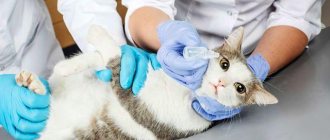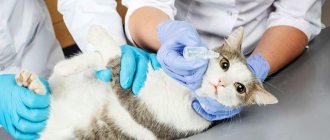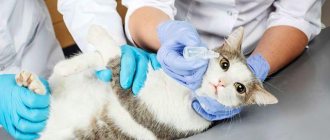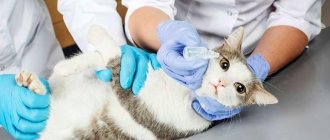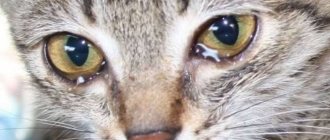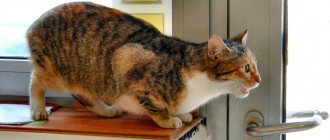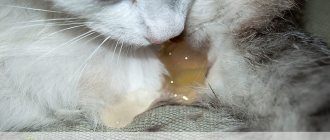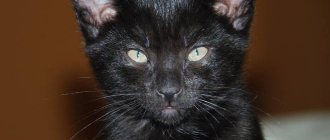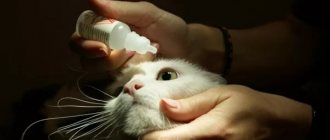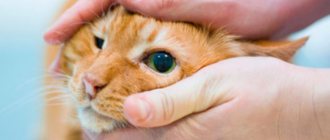Normally, cats always secrete a small amount of clear secretion from their eyes - it cleans the eyeballs of dust and foreign bodies. However, sometimes the color of the discharge takes on a brown tint. Then the cat will have unsightly marks and dark crusts under its eyes. Let's find out whether this is normal or pathological, and in what cases the help of a veterinarian is needed.
Cosmetic defect
Brown discharge from the corners of the eyes in cats is not always a sign of pathology. The cornea is constantly washed by tear fluid, but under certain circumstances it becomes larger.
The amount of discharge increases in strong winds, due to bright light, if the cat is in a dusty or smoky room.
The tear fluid contains substances that, when exposed to ultraviolet radiation, acquire a brownish tint. Dark discharge is most noticeable in the following cats:
- with light coat color;
- with a flattened muzzle;
- in older individuals;
- in emotional pets - when they purr, they produce copious amounts of tears or saliva.
Minor discharge, which over time turns into dried brown crusts, is not a pathology and does not threaten the cat in any way. This is just a cosmetic defect. Brown marks are usually removed using daily hygiene products.
Attention! You should not wipe your cat's eyes with hydrogen peroxide. If it comes into contact with the mucous membrane, the solution may cause irritation and discomfort.
Symptoms - how to understand that your cat is sick.
There are many unpleasant diseases that can affect your pet's vision. It is important to recognize them in time and seek qualified help, because the lack of treatment or untimely intervention by a specialist will aggravate the situation and even lead to complete or partial loss of the pet’s vision.
You should be seriously concerned about the condition of your furry friend if you notice the following symptoms:.
- Brown discharge from a cat's eyes, often mixed with pus, indicates the presence of a bacterial infection in the animal's body. Additional symptoms in this case may include lethargy and nasal discharge.
- Clear discharge, as well as abundant and thick discharge, warns you of a viral infection.
- Brown discharge most often appears when the tear ducts malfunction.
- If a cat has swollen eyes and waters with ordinary tears, without any admixture of pus, but in large quantities, she sneezes and itches, then most likely this is an allergic reaction. This disease is also heralded by redness of the eyelids and their swelling.
- Reddish discharge from the eyes can easily be confused with brown if the cat has a dark fur color.
- Watch his reaction to others - is the cat making contact or has he become unsociable?
- Has his appetite changed?
- Check for scratches and other mechanical damage near the eyes.
- Try to find out what color the discharge from the pet’s eyes is, and whether there is any admixture of pus in it.
Perhaps they are not so pronounced, and it is difficult for you to decide what exactly is bothering your pet. In this case, it is worth observing his behavior.
If all these symptoms are absent in your case, and the cat’s eyes are watering with ordinary transparent tears, then there is no reason to panic. There are a number of reasons why even a healthy animal can have watery eyes. This is an unsuitable diet, characteristics of the breed, an allergic reaction to certain components or substances.
Types of pathological discharge from the eyes
During pathological processes, cats develop discharge that differs in color and consistency:
- Transparent. If your cat's eyes are watery but a colorless liquid exudate is coming out, this may be a sign of an allergy.
- White or light yellow. Such discharge most often occurs due to a viral or fungal infection.
- Saturated yellow or greenish (purulent) is a sign of infection with pathogenic bacteria.
- Brown or reddish discharge with a thick consistency. This color indicates that they contain red blood cells.
Diseases and pathologies that cause disturbances in the outflow of tears from the eyes through the lacrimal ducts
This group includes:
- Narrowing of the tear ducts of an inflammatory nature.
- Stenosis of the lacrimal openings (too small tubules).
- A foreign object that has entered the lumen of the lacrimal canal.
- Eye injury, as a result of which the functioning of the lacrimal system was disrupted.
- Dacryocystitis (non-infectious inflammation of the lacrimal sac).
- Allergy.
- Tumors, neoplasms, compressing tubules.
© shutterstock
Causes of discharge from eyes in cats
There are many reasons why a cat has brown discharge coming from its eyes. The problem can be caused by injury, infection, inflammation or even a tumor.
Impaired outflow of tear fluid
Dacryocystitis is one of the possible causes of bloody discharge in the corners of the eyes. This is a pathology in which the passage of tear fluid through the nasolacrimal duct becomes difficult.
The reasons for obstruction are as follows:
- Inflammation of the walls of the lacrimal canal, which leads to its narrowing and blockage. As a result, fluid stagnation occurs. A pathogenic microflora develops in the lacrimal sac, and a mucous secretion mixed with blood begins to be released from the corners. The inflammatory process is accompanied by redness of the eye and discomfort. The cat becomes restless.
- Narrowing of the lacrimal opening, or stenosis. This pathology occurs in cats, which often suffer from conjunctivitis. The chronic inflammatory process helps to reduce the diameter of the lacrimal opening. As a result, fluid constantly accumulates in the eye and flows out from the inner corner. Stenosis can be not only acquired, but also congenital. In this case, the problem can only be solved through surgery.
- Injury. During active play on the street or at home, cats sometimes bump into sharp objects and injure their eyes. When the eyelids are torn or cut, the tear duct often suffers. In this case, black discharge appears from the eye because the tear fluid contains a large amount of blood. It is important to seek help from a veterinarian immediately. If necessary, he will stitch the eyelid and help restore the patency of the nasolacrimal duct.
- Tumor. If the eye becomes less mobile and hurts, and brown tears flow from the corner, this may be caused by a benign or malignant neoplasm. The presence of blood in the tear fluid indicates tissue damage. Only surgery will help with the tumor. For eye cancer, treatment with chemotherapy is mandatory.
- Foreign body in the lacrimal canal. Motes such as grains of sand, dust particles, and insects can get into a cat's eyes. Together with tears, small foreign bodies sometimes penetrate the ducts of the nasolacrimal canal, which leads to its blockage and inflammation. The cat feels discomfort when blinking and tries to wash its eye with its paw. This causes even more irritation. Treatment involves removing the foreign body by washing or bougienage, as well as the use of local antiseptics.
Infectious diseases
Inflammation of the eyes, which is often accompanied by copious brown discharge, may be one of the symptoms of an infectious disease:
- chlamydia;
- toxoplasmosis;
- panleukopenia;
- calcivirosis;
- rhinotracheitis.
With such serious illnesses, the cat’s health deteriorates. She becomes lethargic, loses appetite, body temperature rises, and her coat looks unkempt. With some infectious diseases, kittens bleed not only from the eyes, but also from the nose. The eyelids become swollen and red.
Attention! If such symptoms are detected, you should immediately seek veterinary help. If left untreated, your cat may die from a viral infection.
Brown discharge also appears with ophthalmological diseases, which can be caused by a bacterial, viral or fungal infection. These include:
- conjunctivitis – inflammation of the mucous membrane of the eye;
- blepharitis – eyelash follicles are affected;
- keratitis – inflammation of the cornea;
- anterior uveitis - infection affects the blood vessels of the eyes.
In all of these cases, a sick cat may develop brown tears from one or both eyes if the inflammation has affected the vessels and capillaries.
Other pathologies
Cats sometimes have watery eyes due to problems with their internal organs. Diabetes mellitus, kidney, liver or intestinal diseases are often accompanied by brown discharge from the organs of vision. Also, a similar problem occurs when infected with helminths.
In rare cases, tearing occurs due to dietary errors, for example, when a cat owner feeds her dry and wet food at the same time.
In Sphynxes and Cornish Rexes there is such a pathology as entropion of the eyelid, in which brown discharge also flows from the eyes. Long-haired cats “cry” when hairs get on the mucous membrane of the eyeball.
Attention! Eyes can fester in any animal, regardless of their gender or age. However, cat breeds with a flattened face - Scottish, British and Persian - are especially susceptible to this pathology, because they have a shortened nasolacrimal duct.
Prevention
Prevention consists of monitoring and caring for your pet. Most breeds do not require intervention, however, in the case of cats with flattened faces, it is necessary to remove the discharge when it appears. The natural secretion, when dried and oxidized, forms a good environment for the growth of bacteria. This increases the risk of developing diseases.
Eye diseases in kittens! Herpes of the eye and calicivirus in cats.
To prevent discharge, it is recommended not to give your cat sweets. Animals metabolize sugar worse than humans. Some of the breakdown products enter the bloodstream and cause a reaction from the immune system. This causes discharge from the eyes, itching and redness of the skin.
All information posted on the site is provided in accordance with the User Agreement and is not a direct instruction to action. We strongly recommend that before using any product, you must obtain a face-to-face consultation at an accredited veterinary clinic.
Diagnostics
If the owner notices brown discharge around the cat's eyes, he needs to take the pet to a veterinary clinic. In most cases, examination and history is sufficient to make a diagnosis.
Sometimes it is necessary to conduct additional tests to help rule out head and eye injuries, as well as diseases of internal organs and infectious diseases. To do this you may need to do:
- Ultrasound of the organs of vision;
- X-ray of the skull;
- blood and stool tests.
Eye diseases accompanied by exudate
In general, in veterinary ophthalmology there are enough eye pathologies accompanied by the appearance of abundant discharge from the conjunctival cavity:
- Keratoconjunctivitis. This is a combination of inflammation of the conjunctival cavity and cornea. In advanced cases, it can lead to blindness.
- Blepharitis. This is what inflammation of the eyelids is called.
- Keratitis. This is a “pure” inflammation of the cornea.
- Uveitis. This is the name for inflammation of the border, the base of the eyeball.
- Iridocyclitis. This is an inflammation of the blood vessels that supply the eyeball.
Most of these diseases are very dangerous and, if left untreated, can lead to complete blindness of the animal.
Treatment and prevention
Depending on the cause of inflammation, the veterinarian develops a treatment regimen for the cat:
- In some cases, local therapy using drops or ointments with antimicrobial, analgesic and anti-inflammatory effects is sufficient.
- If brown discharge appears due to congenital pathology of the eyelids, surgery is recommended.
- Surgery cannot be avoided when a cat has an eye tumor.
- If the tear ducts are clogged or blocked, rinsing helps, but if they are narrowed, surgery may be necessary.
- If a kitten is diagnosed with an infectious disease, one of the symptoms of which is purulent eyes with brown discharge, then the pet is treated not only with eye drops, but with antiviral drugs and immunostimulants.
- For helminthiasis, which is accompanied by tearing, antiparasitic drugs are used.
Types of eye drops for cats
In most cases, treatment for brown discharge involves the use of topical eye medications. These include drops and ointments. They are divided into 3 groups - antimicrobial, antibacterial and antiviral (immunomodulatory).
Antiseptic drops
Antiseptics can be used for the prevention and treatment of ophthalmic diseases:
- Ophthalmosan. A preparation based on chlorhexidine and succinic acid. These components inhibit the development of pathogenic microflora. For brown discharge in cats, use 2-3 times a day, 2 drops under the lower eyelid. The duration of the course of treatment is determined by the veterinarian.
- Lacrican. The main component is the antiseptic polysept, which prevents the proliferation of microbes. The drug also contains anesthesin, a substance with an analgesic effect. After preliminary cleaning of brown discharge, 2 drops of medicine are injected under the cat’s lower eyelid. The procedure is carried out 2 or 3 times a day for 8–10 days.
Antibacterial drops
These are drugs that destroy gram-positive and gram-negative bacteria - chlamydia, mycoplasma, staphylococcus, Pseudomonas aeruginosa, etc. These microorganisms cause inflammation of the organs of vision, which is accompanied by purulent and brown discharge. List of medications for cats:
- Tsiprovet. It is prescribed for acute or chronic conjunctivitis, keratitis, blepharitis, and corneal ulcers. The active ingredient is ciprofloxacin. Directions for use and dosage for cats: 1 drop in each eye 4 times a day; the course of treatment for brown discharge is 1–2 weeks (until complete recovery).
- Dekta-2. The active ingredient here is gentamicin. It has a wide spectrum of antibacterial action. The medicine also contains dexamethasone, a glucocorticosteroid. This is an anti-inflammatory component. Directions for use: 2-3 drops into the conjunctival sac of the eye 2-3 times a day. The course of treatment is from 5 to 10 days.
- Lakrimin aseptic. Broad-spectrum eye drops based on chloramphenicol and sodium sulfosalicylate. The drug is used for eye diseases with purulent discharge, as well as for postoperative complications and wounds of the eyelids or cornea. Directions for use: 2-3 drops 2-3 times a day for 5-7 days.
Immunomodulatory
This group includes cat drops, which are indicated for use in eye diseases caused by viral infections:
- Anandin. The drops have an immunomodulatory, anti-inflammatory and regenerating effect. For brown or purulent discharge under the cat's eyelid, administer 2 drops of medication in the morning and evening. The course of treatment is from 5 to 7 days.
- Maxidin. The drug is based on an organic compound of germanium, which has high antiviral activity, and also has an anti-inflammatory and regenerating effect. Drops are used to treat conjunctivitis and keratitis of an infectious and allergic nature. Directions for use: 1 or 2 drops under each eyelid 2 times a day until the symptoms of the disease disappear.
How to rinse and apply eye drops at home
Before using medicinal products, it is necessary to clean the cat's eyelids of brown discharge. To carry out the procedure, you will need the help of another person, because the cat will struggle. It is necessary to prepare in advance clean cotton pads (5-6 pieces for each eye), as well as a means for hygienic treatment:
- strained chamomile decoction;
- furatsilin solution – 1 tablet per glass of water;
- weak solution of boric acid.
If none of the above is at hand, you can rinse your eyes with warm boiled water. A cotton pad is generously moistened and gently wiped over the cat's eyelids in the direction from the outer corner of the eye to the inner.
Dirty sponges are put aside - you need to take a clean one every time. It is important to remove all brown discharge and crusts. Only after this the eyes are instilled with a medicinal composition.
Attention! The eyelid cleaning procedure is carried out before each use of eye drops.
Treatment of the disease
If a cat has brown discharge from its eyes, it must be taken to a veterinary clinic as quickly as possible. Treatment methods are different and depend on the cause of the pathology, so a thorough diagnosis is first made.
If you have to wait until the main treatment is prescribed, the owner can use home anti-inflammatory therapy. It consists of washing the eyes with antibacterial solutions prepared independently. Suitable for washing are: boiled water, strong tea leaves, furatsilin solution, boric acid solution.
Washing should be carried out as follows:
- secure the kitten firmly, holding it by the paws;
- Dip a cotton swab into the solution, and, parting the eyelids, squeeze the excess liquid into the eye;
- in case of eyelids sticking together, carefully soak the crusts by briefly applying a damp swab to the eyelids;
- rinse the eye, simultaneously removing discharge, with movements in the direction from the outer to the inner corner of the eye;
- Always treat both eyes, changing tampons.
Prevention of eye discharge should consist of observing the rules of eye hygiene and general hygiene, maintaining immunity at a high level, timely deworming, and proper feeding. All these measures are a necessary condition for maintaining the cat’s ophthalmological health. And healthy eyes mean a cheerful, active, beautiful pet for many years.
Preventive measures
To prevent brown discharge from appearing again in a cat, the owner of the animal should pay attention to the prevention of ophthalmological diseases. What exactly needs to be done:
- accustom your pet to good quality food;
- In the room where the cat lives, it is advisable not to use deodorants or smoke;
- adhere to the vaccination schedule;
- carry out antiparasitic treatment in a timely manner;
- protect the cat from contact with sick animals;
- support the cat’s immunity with vitamin and mineral complexes;
- Wipe your pet's eyes daily with hygiene lotion.
The health of the pet is in the hands of the owner. And if a cat has brown or reddish discharge in the corners of its eyes, it is better not to waste time, but to contact a veterinary clinic. If left untreated, purulent inflammation can lead to vision loss.
